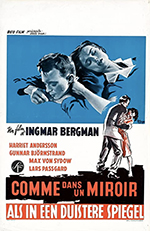
Forced to Live in Reality
"Now I'm in one world, now in the other."
Ingmar Bergman's Through a Glass Darkly (1961)
Points
for Reflection
Ingmar Bergman's Through a Glass Darkly (1961)
- does this film’s title comment not only on humanity’s incomplete knowledge of God and itself, but the likely state of the audience’s understanding of the film? Is the film an indecipherable enigma?
- at what critical moments does Bergman insert Bach’s Suite No. 2 in D minor for Cello (BWV 1008), and why might he have chosen this particular music as a structural pillar for this film?
- is there anything about this family’s relational dynamic that seems like it could either cause or worsen certain forms of mental illness?
- who is the most fragile character?
- why might Minus have chosen a chapel of St. Teresa of Ávila for his play’s setting?
- does Minus’s play seem more an oblique commentary on artistic production in general, or a pointed comment aimed at a particular audience?
- who is the more prolific writer, Minus or David?
- does Karin know herself well?
- does Karin perceive important things hidden from the others, or should we class her unique observations as wholly delusional?
- which characters call Karin “little Kajsa,” and why?
- what does Karin fear? Do her longings overwhelm her fears?
- what do you make of Karin’s three experiences in the upper, dilapidated room covered with wallpaper? Do they grant her freedom and release, imprison her, or . . .?
- for those of you familiar with “The Yellow Wallpaper” (1892) . . . does these moments upstairs appear to echo key features of Charlotte Perkins Gilman’s short story?
- at what point does the nature of Karin’s illness reveal itself?
- these characters define love differently, or share a common vision of the concept?
- what do the very first things we learn about the novelist, Martin, suggest about his character?
- does David’s creative work grant him pleasure?
- what do the few lines shared from David’s novel suggest about the nature of his storytelling?
- how even-tempered does this literary artisan (David) appear when around others? When by himself?
- what might Martin mean when he says David is always “courting” a god in his work?
- do Martin’s late revelations about himself make him more sympathetic to us?
- does Martin’s affection for Karin appear kind and healthy?
- when questioned about his “innermost thoughts” by David, Martin claims that he’s “not very complex.” Should we take at face value his denial that he’s never wished Karin would die?
- Harriet Andersson (Karin) and Max von Sydow (David) were about 29 and 32 yrs old when this was filmed. Do the characters' respective ages appear as close as the actors' ages?
- do Martin and Karin share a similarly strong commitment to one another?
- is sex an important part of Karin’s and Martin’s marriage?
- how often does Martin make eye contact w/ Karin?
- does Martin, a practicing doctor and university lecturer, appear to care for his wife—also his patient—in ways that empower her?
- Karin claims that one who “loves for real always does right by [their] loved one.” Does the totality of the film provide an illustration of what doing right by someone--of truly loving them—might look like?
- Martin refers to Karin as “little” a few times. Does she use the same diminutive?
- does Karin’s and Minus’s sibling relationship appear healthy?
- what happens between Minus and Karin in the derelict, grounded ship during the storm?
- in the last scene shot in the upstairs room, it looks as though a door opens of its own accord. Does this actually happen, or is this Karin’s delusion?
- the film floats a number of possibilities about the nature of God. Does any one suggestion materialize, gaining more authority than the others?
- which parts of the film feel like a staged play?
- Karin says: “If you look long enough with your head tilted to one side, it gives you the creeps.” Does Bergman employ any canted (“Dutch”) or Bavarian (90 degree) angles?
- do we hear the things Karin hears that others do not?

Through a Glass Darkly (1961)
one sheet
Dr. Paul Marchbanks
pmarchba@calpoly.edu
![]()
